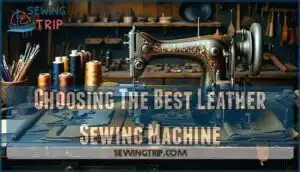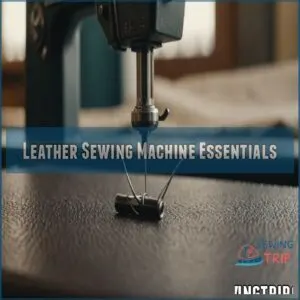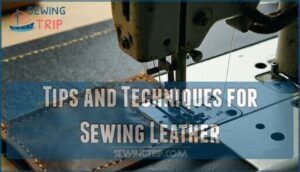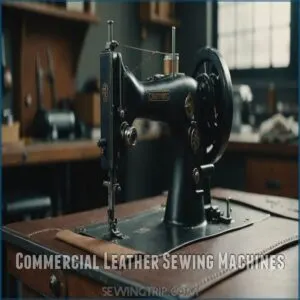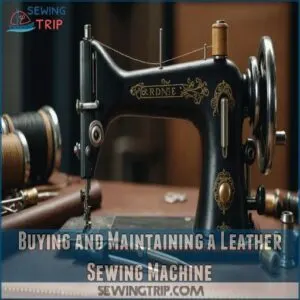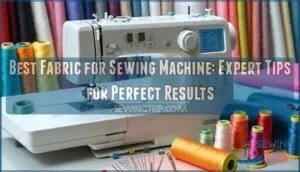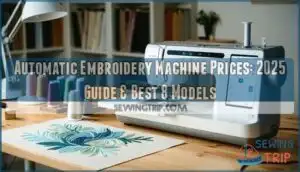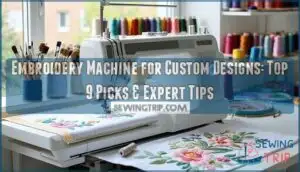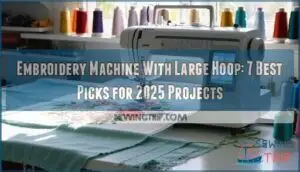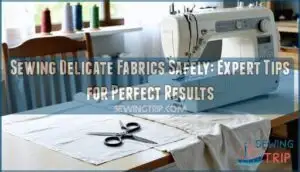This site is supported by our readers. We may earn a commission, at no cost to you, if you purchase through links.
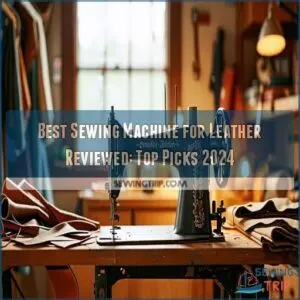 Choosing the best sewing machine for leather is like finding the perfect pair of boots—durability and fit are key.
Choosing the best sewing machine for leather is like finding the perfect pair of boots—durability and fit are key.
The Juki DNU-154 is a standout with its walking foot mechanism, handling leather like a champ. The Consew 206RB-5 is another option, eyeing something heavy-duty with its robust build.
Budget-conscious? The Singer 4432 packs a punch without breaking the bank. Look for features like automatic needle threaders and adjustable feeds, making leather sewing a breeze.
Whether you’re stitching a leather jacket or crafting a luxe bag, these machines promise power and precision.
Table Of Contents
Key Takeaways
- You’ll want a heavy-duty sewing machine with features like a walking foot mechanism and automatic needle threader to handle leather’s thickness effortlessly.
- Consider the type and thickness of leather you’ll be working with to determine whether a domestic or industrial machine suits your needs.
- Essential features like a sturdy metal frame and adjustable feed mechanisms ensure smooth fabric feeding and precise control over your leather projects.
- Picking the right needle size and thread type, like polyester or nylon, is vital for strong, durable stitches and preventing needle breakage during leather sewing.
Choosing The Best Leather Sewing Machine
To choose the best sewing machine for leather, focus on key features such as a heavy-duty metal frame and adjustable feed.
Consider the types of leather you’ll use and whether a domestic or industrial machine suits your needs.
While ensuring you have the right needles and threads for top performance.
Key Features to Consider
When picking the best leather sewing machine, consider these features, including a strong walking foot and adjustable stitch length for smooth handling of thick fabrics, as seen in top-rated models like leather sewing machines. When picking the best leather sewing machine, consider these features.
First, the Machine Space Requirements make sure it fits your workspace.
Prioritize Leather Thickness Handling and Motor Power Considerations for dealing with heavy duty tasks.
A versatile Presser Foot Options enhances adaptability.
Types of Leather and Machine Compatibility
Now that you’ve considered key features, let’s talk leather types.
Leather thickness, from lightweight garment leather to heavy upholstery, dramatically impacts machine choice. This is because leather thickness varies greatly, and the right machine must be able to handle the specific type of leather you are working with.
Grain type—full-grain, top-grain, or genuine—affects durability and sewing ease. This is important to consider because different grain types have different properties that affect how they can be sewn.
Remember, hide versus split leather greatly changes its strength and sewing needs. This is a key distinction to make, as hide versus split leather can make a big difference in the type of machine you need.
Also, natural versus synthetic leather requires different needles and thread. Choosing the right machine depends on the leather types you’ll be working with.
Consider leather weights and your project demands before selecting a leather stitching machine.
Domestic Vs Industrial Machines
Choosing the best leather sewing machine means understanding domestic and industrial options.
Domestic machines offer portability and are great for home projects, tackling leathers with ease.
In contrast, industrial machines pack more engine power and durability for heavy-duty tasks like leather repair and upholstery.
Consider your leather machine size and user experience needs before deciding which type fits you best.
Needles and Threads for Leather Sewing
After you’ve understood machine types, focus on leather needle sizes, and consider investing in specialized equipment from online retailers like those offering leather stitch machines and accessories, such as leather stitch machines.
A leather needle, sturdy with a sharp tip, is your sidekick for stitching leather.
Pair it with waxed thread for durability and vibrant thread colors that match your project.
Regular needle maintenance keeps operations smooth, while specialty threads cater to leather’s demands, keeping your creativity unchained and flowing effortlessly.
Leather Sewing Machine Essentials
When you’re sewing leather, having the right sewing machine features is essential for smooth and precise stitching.
Focus on essentials like a heavy-duty metal frame, adjustable feed, and control to handle the robustness of leather with ease.
Heavy-Duty Metal Frame and Adjustable Feed
Imagine tackling leather projects without straining your machine.
A heavy-duty metal frame bolsters durability, letting you stitch smoothly.
For smooth fabric feeding and reduced friction, look for a machine with a stainless steel bedplate, like the Singer Heavy Duty sewing machine.
Adjust the feed mechanisms to control tension and tackle even thick materials.
Feed dogs grip in harmony with an adjustable stitch length and a robust motor, giving you precise control and ensuring your leather creations look professional and polished.
Automatic Needle Threader and Longer Stitch Length
Two key features for leather sewing are an automatic needle threader and a longer stitch length.
An automatic needle threader saves you time and frustration, eliminating threading problems.
Longer stitch lengths are essential for stronger seams in thicker leather.
Stitch length control gives you more stitch options, impacting the overall look and durability of your project.
Master leather sewing with these essential features.
Walking Foot and Speed Control
Mastering leather sewing requires understanding the importance of a quality machine, such as the best leathercrafting sewing machine. Mastering leather sewing requires mastering your machine’s essentials.
A walking foot ensures consistent stitching, while speed control helps navigate tricky seams easily.
Consider checking out dedicated leather sewing machines online at leather sewing products for the best results.
- Walking Foot Benefits: Keeps layers aligned, reducing fabric slips.
- Speed Control Importance: Adjusts pace for precision work.
- Foot Pressure Adjustment: Adapts to leather thickness, ensuring clean stitching.
These features promise efficiency and excellent results.
Stitch Type and Versatility
When you’re cruising with speed control and a steady walking foot, your next stop is stitch type versatility. Different leather projects call for varied stitches. Table: Stitch Type Benefits
Tips and Techniques for Sewing Leather
Mastering leather sewing involves choosing the right needle and thread, adjusting tension, and tweaking stitch length for best results.
By understanding techniques to handle thick or thin leathers, you’ll prevent issues like sticking or breaking, ensuring a smooth sewing experience.
Using The Right Needle and Thread
When considering the motor specifications of a leather sewing machine, such as motor speed and torque, it’s crucial to choose the right machine for leather thickness. After exploring leather sewing machine essentials, addressing needle size and thread type can’t be ignored.
Opt for a titanium nitride needle for durability, ensuring it’s compatible with your sewing machine.
For best results, consider the significance of choosing the right presser foot pressure when sewing with leather.
Use polyester or nylon thread to minimize breakage.
Selecting the right tools helps prevent needle breakage and sewing precision when tackling leather projects.
Adjusting Tension and Stitch Length
Balancing tension and stitch length in leather sewing makes you feel like a maestro.
Too tight, and your fabric wrinkles; too loose, and stitches fall apart.
Adjust tension for the thread type and needle size to prevent issues.
Experimenting with stitch length impacts leather sewing cost effectively, helping your stitches hold strong without leaving excess marks.
Working With Thick and Thin Leathers
Leather sewing isn’t as challenging as it seems with the right approach.
Consider leather thickness with projects.
Here’s how:
- Use proper needle selection: Choose needles that match thickness, like 110/18 for heftier hides.
- Experiment with stitch types: Longer stitches often work best.
- Machine adjustments are key: Tweak tension and utilize models like Juki DNU-1541 for a smooth experience.
Preventing Sticking and Breaking
Prevent sticking by using the right needle and thread; a sharp leather needle and strong polyester thread are your best friends.
Proper machine maintenance, including lubrication, is very important.
Adjust your thread tension; too tight, and you’ll snap threads; too loose, and your stitches won’t hold.
Fabric preparation matters too.
| Tip | Benefit |
|---|---|
| Leather lubrication | Prevents sticking and machine wear |
| Needle selection | Prevents skipped stitches and breakage |
| Thread tension adjustment | Makes sure strong, even stitching |
| Fabric preparation | Easier feeding, prevents jams |
Commercial Leather Sewing Machines
When you’re ready to handle more demanding leather projects, consider investing in a commercial leather sewing machine like the Consew 206RB-5 or Juki DNU-1541.
These machines are built to tackle thicker materials efficiently, offering features that guarantee precision and durability for heavy-duty tasks.
Consew 206RB-5
Mastering leather sewing involves picking the right machine, and the Consew 206RB-5 stands out.
This commercial powerhouse is favored for its robust mechanical construction and high stitches per minute, ensuring durability and efficiency.
Comparing Consew 206RB-5 features against alternatives like Juki reveals its competitive pricing.
Users often praise its reliability in Consew 206RB-5 reviews.
Juki DNU-1541
Considering the Consew 206RB-5’s strong reputation, the Juki DNU-1541 stands shoulder to shoulder with its robust build and advanced features.
Its walking foot mechanism guarantees consistent stitching, even on tough materials.
Whether debating Juki DNU-1541 vs. Consew or Brother alternatives, this machine’s reliability stands out.
Ideal for high-volume projects, it offers power and precision at a competitive price.
Reliable 4000SW
Even when tackling thick leather, the Reliable 4000SW handles with courage.
You’ll love its durable design, making sewing feel like a breeze.
Here’s why it stands out:
- Adjustable Speed: Tailor your sewing pace.
- Stitch Variety: Offers versatility with every stitch.
- Efficient Motor: Delivers powerful, smooth operations.
- User-Friendly Controls: Even beginners find it a joy.
Juki DDL-8700
When tackling leather projects, the Juki DDL-8700’s precision and durability make it a top choice for professionals.
Its affordability and ease of maintenance stand out, especially compared to rivals like the Reliable 4000SW and Brother ST371HD.
| Feature | Detail |
|---|---|
| Needle | Regularly serviced for longevity |
| Price | Competitive in its class |
| Alternatives | Reliable 4000SW, Brother ST371HD |
Singer Heavy Duty 1
The Singer Heavy Duty 1 stands as a robust choice for tackling leather, weaving seamlessly through thick material without breaking a sweat.
Its powerful motor and durable build promise reliability, while its speed limitations might occasionally whisper to slow you down.
For a price that respects your wallet, it competes heartily with the Janome HD3000 and Brother ST150HDH in versatility.
Buying and Maintaining a Leather Sewing Machine
Choosing the right leather sewing machine is a big decision, so understanding its maintenance is key to longevity.
This section will guide you through buying a machine, keeping it in top shape, and troubleshooting any problems that might arise.
Where to Buy a Used Leather Sewing Machine
You’ve explored commercial machines; now, where can you snag a used leather sewing machine deal?
Try these spots:
- Online marketplaces: Great for variety.
- Local shops: Get personal advice.
- Auction sites: Score a rare find.
- Craigslist: Bargains await.
- Facebook groups: Connect with enthusiasts.
These avenues are rich with possibilities for your next project.
How to Maintain and Care for Your Machine
Keeping your leather sewing machine in tip-top shape is essential for longevity and performance.
Regularly oil, clean, and lubricate it to reduce noise levels.
Consider investing in specialized leather work machines to streamline your workflow and improve results.
Proper storage prevents dust build-up, ensuring smooth operation.
Whether you own a Singer 9960 Quantum Stylist or a Tippmann Boss, adhering to a routine maintenance schedule will keep your machine humming along.
| Task | Frequency |
|---|---|
| Oil | Weekly |
| Clean | After use |
| Lubricate | Bi-weekly |
| Storage Check | Monthly |
Troubleshooting Common Issues
As you fine-tune your leather sewing machine, knotty problems might pop up like needle breakage or thread jamming.
Don’t fret, though!
Keeping an eye on foot pressure can fix stitch skipping.
Regular breaks prevent machine overheating.
Remember, a little love goes a long way in resolving common issues, giving you smooth sailing while stitching leather masterpieces.
Upgrading and Accessorizing Your Machine
Upgrading your leather sewing machine enhances its performance, like revamping a classic car with modern parts.
Consider adding Leather Machine Attachments for specialized tasks or exploring Presser Foot Options for improved precision.
Specialty Needles can handle tough materials, while Machine Oil Alternatives keep it running smoothly.
Creating Customized Workstations boosts efficiency and makes certain your machine matches your leather-sewing prowess.
Frequently Asked Questions (FAQs)
What kind of sewing machine is best for leather?
Choosing a sewing machine for leather is like selecting the right tool for a sculptor.
For beginners, the Brother ST150HDH is forgiving.
Experienced users benefit from the Juki TL-2000Qi’s precision and industrial-grade capabilities.
Do you need a heavy duty sewing machine for leather?
You definitely need a heavy-duty sewing machine for leather.
Leather’s thick nature demands a robust machine, with a powerful motor, sturdy needles, and a walking foot to handle its heaviness and guarantee smooth stitching.
Is it better to sew leather by hand or machine?
Crafting leather by hand is like painting a masterpiece, demanding patience and finesse.
Machines provide speed and consistency, essential for large projects or tough materials.
Choose based on your project’s needs and your comfort level with either method.
Can a Janome sewing machine sew leather?
Janome sewing machines are part of the best leather sewing machines, offering heavy-duty construction like the Janome HD3000 model, can handle leather, especially if you use a leather needle and thread.
These machines blend durability with user-friendly features, ensuring smooth operation.
Adjust the stitch length and tension for best results.
What needle size is best for leather?
Tackling leather is like facing a tough opponent.
The best needle size ranges from 110/18 to 120/
This guarantees clean, crisp stitching without needle breaks, perfect for handling leather’s thick, stubborn texture efficiently, making it perfect for thick, stubborn texture.
Can I sew suede with a leather machine?
You can definitely sew suede with a leather machine.
Just use a leather needle and heavy-duty thread to avoid issues.
Adjust your stitch length and tension for a smooth experience, ensuring the suede doesn’t shift.
How do I clean my leather sewing machine?
First, unplug your machine, then dust it with a soft brush.
Next, use a dry cloth to clean surfaces, avoiding water.
Oil moving parts with specified lubricant.
Perform regular maintenance for best performance and smooth stitching.
What type of thread works best for leather?
When sewing leather, use polyester or nylon thread for durability and strength.
These threads withstand leather’s demands, preventing breakage.
Avoid cotton, as it can weaken and snap under tension.
Choose matching thread color for a polished look.
Whats the best stitch length for leather?
A stitch length of 3 to 5 mm often works best for leather, balancing strength and flexibility.
Avoid too-short stitches—they can weaken the leather by causing perforations, resulting in tears or splitting over time.
Conclusion
Finding the perfect leather sewing machine can feel like searching for a unicorn, but it’s absolutely achievable with the right guidance.
Whether you’re eyeing the Juki or the reliable Consew, there’s a model that fits your needs and budget.
Consider essential features like a walking foot and automatic needle threader for a smooth sewing experience.
With the Bernina 560 featuring 676 stitches and 5 alphabets, along with a large, bright color touchscreen for easy navigation as seen in Bernina 560 reviews, you’re well-equipped to start leather projects with confidence and flair.

